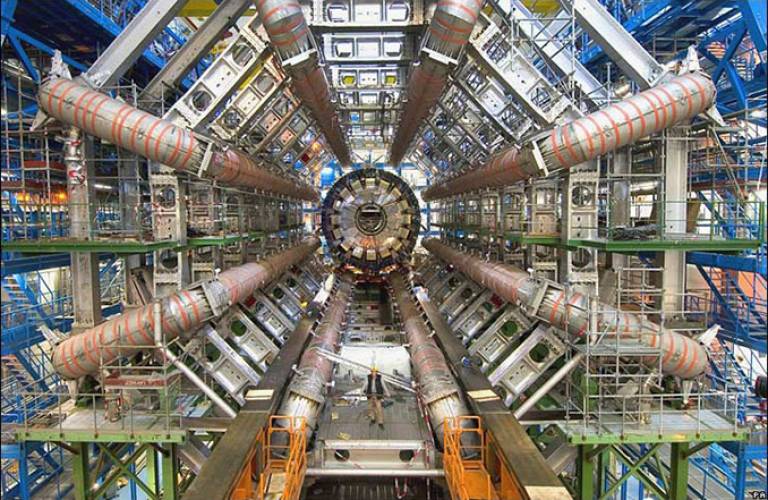Engaging the public with physics, the Large Hadron Collider and the discovery of the Higgs boson

16 December 2014
The switch-on of the Large Hadron Collider and the discovery of a Higgs boson have stimulated interest in science and engineering, and particularly in physics, on a scale unprecedented by any other single experiment. UCL physicists have helped explain the discovery to the public through talks, media appearances and blogs.
Physicists at UCL were involved in the 2012 discovery of the sub-atomic particle the Higgs boson, which is crucial in our understanding of the mass of fundamental particles.
An international group of scientists, including those from UCL, carried out the research at the Large Hadron Collider (LHC) in CERN, Switzerland, the largest physics experiment ever built. The discovery marked a major breakthrough in our knowledge of the fundamental structure of matter.
Professor Jon Butterworth (UCL Physics & Astronomy) led the UK contribution to the ATLAS detector between 2007 and 2009, one of two general-purpose particle detectors at the LHC. UCL researchers were involving in constructing ATLAS's detectors, building electronics, writing code and working on the mechanical engineering of the Semiconductor Tracker, an essential component of the detector. They also made important contributions in the experiment's measurement and analysis.
The LHC began operating in late 2009, and on 4 July 2012 the ATLAS collaboration announced the discovery of a new particle, since shown to be a Higgs boson. It was discovered by measuring the results of proton-proton collisions at the LHC. Many particles are produced in these collisions, and identifying the evidence for a new particle, such as the Higgs boson, was a huge instrumental and analytical challenge.
The research stimulated an unprecedented interest in particle physics among the public, and the UCL staff involved in the CERN research have been at the forefront of efforts to describe the work and explain its significance to the wider public. This has included creating Colliding Particles, a series of 12 short films for schools, and involvement in an award-nominated BBC Horizon programme, alongside many talks at schools and public events. Since December 2009, Professor Butterworth has written a blog, Life and Physics, which is now part of the Guardian website and reaches an average of more than 50,000 readers a month.
Related links
- Life and Physics blog
- UCL Physics & Astronomy case studies
- UCL Faculty of Mathematical & Physical Sciences case studies
Image
- Large Hadron Collider/ATLAS at CERN. Courtesy of CERN.
 Close
Close

